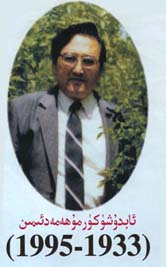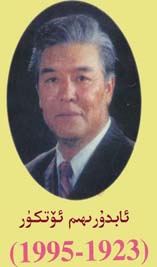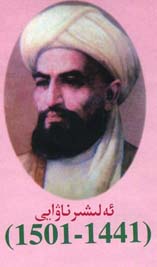Uyghur Language
Studies
Together we live this language.
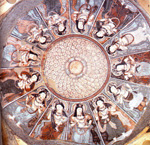 A land without ruins is a land without memories -- a land without memories is a land without history.
A land without ruins is a land without memories -- a land without memories is a land without history.
Abram Joseph Ryan
Never interrupt your enemy when he is making a mistake.
- Napoleon Bonaparte
Uyghur History
Early Uyghur History
The Uyghurs are descendants of nomads who trace their origin back to the Uyghur knanates, which ruled an area stretching from the Lake Baikal in southern Siberia to the Karakoram more than 1,000 years ago. According to legend the Uyghurs descended from Wugsi, a heroic figure who consumed wine and raw meat as an infant and could walk at the age of 40 days. His grandsons founded 24 clans.
The Uyghurs are regarded as the first Turkic people to settle down, perhaps as early as the A.D. 5th century. In the A.D. 8th century they were under the control of the East Turkic Steppe Confederation. When that fell part they and the Karluks took control of an area in present day western Outer Mongolia and helped the Tang defeat a rebellious general.
In A.D. 840 they were driven from Mongolia by the Kyrzyg and dispersed in many directions. Many settled where the live now in the oasis towns in the Taklamakan Desert, where the Chinese occasionally had a military presence. Near Turfan and Kucha the Uyghurs established a kingdom based on agriculture and trade.
The Uyghurs of this period embraced shamanism, Manichaenism. Nestorian Christianity, and Buddhism. Early Uyghur branches included the Buddhist "Yellow Uyghurs” of Gansu, the Buddhist Karakhoja Uyghurs of Gaochang (present-day Turpan), and the great Muslim Qarakhan dynasty that ruled over much of modern-day Kyrgyzstan, eastern Kazakhstan and western China.
Many Uyghurs were Manichaens, followers of the Persian saint Mani, the “ambassador of light,” who merged Zoroastrian with Christianity. An inscription from one of their ancient cities describes how Manichaenism transformed “this country of barbarous customs, full of the fumes of blood, into a land where people live on vegetables; from a land of killing to a land where good deeds are fostered
Later Uyghur History
The Uyghurs made a smart decision by choosing to be absorbed by the Mongols rather than fighting against them. In the court of Genghis Khan they acted as diplomats between the Mongols and the great powers of Central Asia. Marco Polo described them as a friendly, fun-loving people.
Uyghur were oasis farmers who developed sophisticated irrigation systems. Some were herders. Many were merchants and traders who worked along the Silk Road.
Silk Road caravan Some Uyghurs embraced Islam when it arrived in the region in the 9th century but many didn’t convert until after the Mongols did, much later. Some didn’t embrace the religion until the 1450s, long after they adopted Arabic script for writing the Uyghur language. Apa Hoja, a 17th century Uyghur ruler, has become a "symbol of Muslim identity tolerated by the Chinese.”
Uyghur history has been a series of conquests by and rebellions against the Chinese. Many of the Uyghurs in Central Asia moved their during a period of Chinese persecution in he 19th century. They were not unified one leadership until 1884 when the Qing government took control of Uyghur Region.
Eretna Dynasty in Encyclopædia Britannica
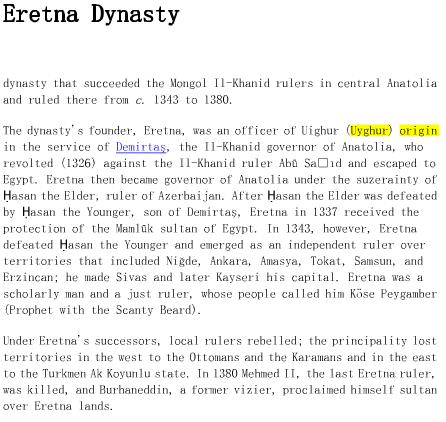
Chronicles of Silk Road
5500 BC - 2455 BC Sumerian culture.
The first cities, literature, written laws, astronomical calculations, schools, pyramids, etc. The Sumerians spoke a Ural-Altaic like language, which in vocabulary and grammar shows many similarities to modern Ural-Altaians. Racially they were also unlike their Semitic neighbors.
3800-3200 BC Uruk Period of Sumir history
2470-2326 Acadians Semitic periods in Mesopotamia
The records are filled with complaints from the Sumir inhabitants many of whom probably sought refuge amongst their earlier colonies in Central Asia and other areas as well. Every new Accad king's reign involved the putting down of new revolts.
2326-2256 Guti-Elamite rule in Mesopotamia
The Elamite language is also -like Sumerian- related to the early Ural-Altaic languages in structure and vocabulary. A few early linguists had claimed that it had special affinity to Finno_Ugrian and Hungarian.
2000 BC Linguists estimate the time at which Hungarian broke away from the neighboring Ural-Altaic & Finn-Ugor language family to become an independent language. This is based on the many differences which occur in pronunciation between Hungarian and other Finno_Ugrian languages. Naturally the location where this occurred is highly speculative and unfortunately also very politically biased.
1766 BC China
According to traditions which were eventually recorded, the old Chinese Hia dynastie's 17th member, Kia was removed from his throne due to his evil ways. The son of the emperor, Sunni returned with 500 members of his Hia nationality to his relatives the Hun. There are still Hia in China, whose language still has many common words with Hungarian. These may simply be common words within the Altaic languages that are also common with Hungarian and therefore should not be treated as a direct link.
1200 BC The Cimmerians begin to occupy the South Russian Steppe
c. 1100 BC The legends of turan, recorded by the Persian Ferdusi in his book of kings "Shaname"
The book talks of Afrasiab, the king of Turan [Also a Uyghur dynasty] who is the ancestor of the Ephtalite (White) Huns.
329-28 BC The Invasion of Transoxiana and capture of Samarkand by the Greeks under Alexander the Great, resulting in the rule of the Greek Seleucids in both Bactria and Soghdiana
F. Altheim "Das Alte Iran" writes that the Iranian Avesta's most archaic texts, the Gathas are still not understood by today's linguists. R. Stiehlel "Geschichte Mittelasiens im Altertum" writes in his book about the language of the old Avesta, and it becomes quite obvious that this language is closely tied to the ancient Altaic languages also. It is not surprising that this is the case since the newcomers to Iran settled over the older settled inhabitants from which it borrowed much and who are often associated with the Scythians, Turks and Finno_Ugrians in language. Many of these local people were Iranianized over time and as a consequence today we call certain Scythian nations also Iraninan in origin. Much of the early Persian literature found in Persepolis is not written in Iranian but in the language of the aboriginals speaking an Elamite language which up till the last century was also called Scythian.
c. 200 BC The Emergence of the Huns on the western borders of China.
2nd century BC sees a rise of the Hun Empire's puts pressure on the territory of Iran dislodging many Scythian nations who were also pushed west, including the Saka-Uraka whose kings' title was Makar.
174-161 BC The Hun attack the Yüeh-chih (known in the West as the Tocharians), driving them from Gansu.
141-128 BC The Yüeh-chih, fleeing from the Hun, overrun the Greco-Bactrian kingdom, which is renamed Tocharistan.
138 BC The first Chinese diplomatic mission to the Ferghana Valley, led by Chang Chien.
130 BC Baktria The Asi (Yazig) and Pasiani (Petchegen/Besenyo) and the Tocharian tribes break into Sogdiana and Baktria. The Sabir (Sabarol) tribe is also allied with them. In the next five years two Parthian emperor loose their lives in the wars against these mounted nomads
127 BC Chinese records about the Kushan exodus
The Chinese record that the "Great Yüe Chi " tribes left their homelands in Kansu and moved to Western Turkestan. They had seven tribes which were lead by the Kushan tribe. (Possible connection to the Hungarian Kasi tribe) They were to later found the great Indo-Scythian empire of North India and Central Asia. Their rulers were called the Gula/Jula term common among Hungarians, Avars, Khazars and certain Hun tribes.
51 BC The Hun split into two hordes, with the Eastern Horde subject to China.
AD 48 The Hun Empire dissolves.
c. AD 50 Kujula Kadphises unites the Yüeh-chih to establish the Kushan Empire, stretching from Persia to Transoxiana to the Upper Indus.
23-79 AD Plinius "Indum accolunt MEGARI, .. URI, ABAORTA, OSI" talks of the Magars, Avars ?, and Yazig.
c. AD 78-144 The reign of King Kanishka over the Kushan Empire (territory extended to include the Tarim Basin), with Buddhism as the dominant religion
95 AD Chinese military expedition lead by PanChao reaches as far west as the Caspian Sea in their mad drive to conquer the Huns. After the return home of this great military leader PanChao dies within a year. The western provinces all revolted against China and the power vacuum created was again filled by Hun rule.
139 AD Ptolemaus Claudius geographer writes of the Huns next to the Dnyper in Eastern Europe calling them Khuni and Suni. (note Khuni is the clan/national designation while Suni is probably from Senyu, their ruler).
150 AD Ptolemi The central Asian Magyars are mentioned living next to Parthia. "Quae autem juxta Parthiam et Caramaniam desertam Mazorani tenent." Other ancient maps show the south eastern shores of the Caspian Sea a nation called the Maxera and a similarly named river. This was probably their eastern most outposts.
214 AD Choronei Mozes, "The history of Armenia" Talks of the Huns, Chasi, and Makar/Magyar near the Sarmatian Scythians. Perhaps this is the earliest settlements of the Hungarians near Baskiria, who are also called Mozeryan (ie Magyar) by the Russians and who were the last nation to have a Sarmatian tribe. Herodotus also has the Royal Scythians next to the Sarmatians.. but the Sar-mata term can simply mean royal-lands. " Sarmatai pars altera orientalibus Sarmatae finibus, Riphaeio monte, Tanai flume, Maeotide palude a Sarmata prima distinguitur, atque inde per Caucasos montes propter Iberian, Albanian versus Caspium Mare partient. hae autem gentes plurimae Sarmatiam alteran incolunt: Chasi (Kasi), Basili, Hunni, Guda-Makari,
200 AD Dionisus Periegetes talks of the Huns living next to the Caspian Sea.
3rd cent. The decline of the Kushan and Parthian Empires and the incorporation of Soghd and Bactria into Persia under the Sassanian dynasty.
226 Persia. The Iranians defeat their Parthian rulers, although much of Northern Iran (Chorasan and Merv) remain under White Hun rule until 550 AD. Eastern Iran remains under the Parthian Surena rule while Armenia for 500 years remains under a Parthian dynasty. The Persians rule Fars, Susiana, Mesopotamia and parts of Media. Northern and Eastern Iran is under Hun rule and Persia often pays tribute to them.
300 BC Ancient Greek, Iranian, and Chinese sources placed Uyghurs with their tribes, and sub-tribes in the vast area between the west banks of the Yellow River in the east, Eastern Turkestan in the west, and in the Mongolian steppe in the northeast.
350 AD The Huns engulf Baktria and Eastern Iran and Afghanistan. The white Hun Ephta tribe is the ruling tribe (Greek Ephta, Chinese Yetha). The Persian Bukhani Kate dictionary states the meaning of Haital to mean "big, powerful" in the dialect of Bukhara, which in Hungarian is also "Hatal-mas". The MAS suffix is an archaic Ural-Altlaic-Dravidian-Sumir term for "hero/brave". The Iranian linguists believe this simply means "big".
352 AD Chronicle of Derbent (Caucasus) "70 years before the birth of Mohamed (352AD), the uncountable people of the Magors apeared, who came from the area north [north-west] of Tibet and descended on the plains of Astrakan, here they split into two branches, one of which went north east to live along the river Volga (Magna Hungaria of old maps or more properly Baskiria). The other branch went further west and also founded the city of Madjar [in the Cuban between the Caspian and Black Sea]. " It should however be mentioned that the Madar, Mazar and Makar variations of this name appear for a very long period before this in the Caucasus Mountains, the route by which these eastern Magars supposedly came. However the Saka-Uraka Scythians, whose kings were called
Makar did indeed come from the area described by this chroniclers.. these can be viewed as the most eastern component of the so called Makar/Magar/Magyar designation. These people were not Huns, not Turkic and not even Altaic in origin. However the Hun tidal wave caught up with them anyways and they were engulfed in their new empires. The Caucasian Magyars name is recorded by the Byzanteen Emperor as Subartu Asfalu.
4th cent. The Mongolian Juan-juan Empire is formed in Mongolia.
c. 370 The Huns invade Europe from the Central Asian steppe.
372AD Europe
Under the leadership of Balimir their king, the Huns push toward the west and defeat the Alans. They absorbed a portion of their nation. The Hungarian legend of the miraculous hind claims the Alan/Hun/Magyar mixing in the form of kidnapping of the Alan women occurred next to the Sea of Meotis, which is believed by some historians to be the Aral or Caspian Sea.
374 Ad The Huns conquer the eastern kingdom of the Ostrogoths and take away the territory of the Visigoths, which they had not ruled for a long time. This was in the area of today's Ukraine.
378 AD A Scythian general in the Eastern Roman Empire who is from the Saka-uraka tribe "Royal Scythians" is also called Modar-(es). [remember the Makar title of the Saka Uraka rulers.]
404AD The Hun ruler Uldin helps the Roman general Honorius against the Ostrogoths.
409 The Huns occupy the area of Bulgaria.
420-425AD The White Huns in Transoxiana
The white Huns "Euthalite" arrive in Transoxiana near the Amu-darya and Sir Darya rivers in Central Asia.
Their kings are called Kagans and their queen the Katun. These are the ancestors of the Avar Huns who later enter Europe.
434 The king of the Huns is Ruas (Ruga or Rugulas) dies and his grandson Atilla becomes king.
441- Pharbi Lazarus. The Persian king Izdegerd II. organizes a campaign against the Huns, who are called Kush and for a full two years he battles them without success.
442-444 The Hun war against the Persians under the rule of Jazdagard I.
448 The White Huns establish an empire in the Oxus River Basin.
Priscos Rhetor the Greek envoy often calls them the Kidarite Huns. The Kidara name comes from their leader, which the Hungarian chronicles call Kadar and derives from the Samanid clan. (Samanid dynasty of Chwarezmia)
440 The Hephthalites (White Huns, later known in the West as the Avars) move south from the Altai region to occupy Transoxiana, Bactria, Khurasan, and eastern Persia.
460 The Hephthalites conquer the Kushans and invade India.
450-451 The Second Hun-Persian War during the rule of Jazdagard II.
451 Atilla leads his armies to the Rhine and then across central Germania to Gallia (France). Here the Roman alliance and Hun alliance fight the famous battle of Catalaun. This battle turns out to be a stalemate and the spread of the plague also forces both armies to return home. The following year Attic leads an assault on the Italian peninsula.
453 The death of Atilla and the battles of succession so weaken his empire that it cannot contain the revolt of the various Germanic elements.
454 Another White Hun and Persian War under Jazdagard II.
458-484 Feruz the Persian king asks for military help from the Huns, who under their leader Fa-ghana (according to Firdusi) or other eastern writers Khusna-vaz help.
460 The eastern UAR and the western HIUN tribes unite and the Hepthal becomes their ruling clan. The European UAR and Hunnoi Avar Hun groups are of this same origin.
461 Avar-Hun Legend "A great fog arose from the sea scaring people and this was followed by countless number of vultures descending on the people. For this reason they had to leave this land and were forced to attack the Sabirs. Because the Sabirs lost their lands they in turn attacked the Saragur, Ugor and Onogurs. These in turn asked for an alliance and land from Byzanteum." This legend is also found in similar form in the old Hungarian Chronicles also describing the Hungarian migration. The vultures are often explained as the Turks who defeated and conquered the Avars forcing them to flee. A lot of them died in these battles and some 200,000 left their lands. In their westward migration the Avars absorbed many of the smaller fragmented Hunish tribes like the Utigur and Kutigurs as well as the Ugor nations (Saragur, Onogur, Ugor) and the Sabir elements. Their main tribes were the Auar [Avar], Chun [Hun], Kotzagir .
463 Priscos Rhetor, Greek envoy The Avars attack the Sabirs, these in turn are forced to attack their neighbors the Sara-Gurs (White Ogurs), then Ugors and Onogurs who move to the area of the Black Sea. The Ogur term in the Bulgar and Hunish dialects means tribe/nation. It is from the Onogur name that the Hungarian name is derived.
463 The Ogur Hun nations cross the Volga River (Saragur, Onogur, Ugor)
Zakarias Rhetor, church historian Lists the nations which were converted to Christianity by the Armenians in the Caucasus. Amongst these are the Onogurs, Ogurs, Sabir, white Ogurs, Bulgars and White Huns. These came under the guidance of the bishop of the Dori Goth Metropolis who was also called the bishop of the "Huns and Onogurs". The references also mention the Onogurs living at the same time in the Caucasus and the Crimean Peninsula.
463 Zacharias Rhetor: The Onogurs first cross the river Volga in 463.
484 North east Persia. War between the Huns and Persians during the rule of Sufra.
485 The Avar Huns moves west after growing pressure from Persian and Turks.
525 Zonaras: Mentions that the Romans, under the rule of Justinius asked for military help from a nation in the Caucasus Mountains called Hongre against the Persians.
552 or according to others in 567 the Turks conquer the Central Asian Avar-Hun empire. The turncoat Avar Hun chief Katalpus may have been one reason that this Turk-Persian alliance had such a sucess. According to the Byzanteens the Avars who entered Europe were originally the servants of the original real Avars living on the periphery of Persia. For this reason they separated these two nations. [originally the Turks were the servants of the Avar-Huns?] While they called the European Avars "fake" avars, there is no evidence that they were not the same people that also lived in Afghanistan and northern India. The term "fake" Avars have something to do with the fact that the original Avar or Apar term designated a Scythian and not a Hun people who lived in Central Asia before the Huns came. The Parthians.
555 Thephilaktos Simokata states that before the Turks came to power in Asia they first conquered the Hephtalites (white Huns), then the Avars, then the Ogurs. After their defeat, one portion of the Avars moved to areas north of China while the Ogur tribes which were also called Uar and Hunnoi went toward Europe.
Menandros: The language of the Avars is the same as that of the Huns, but they wear long braids with ribbons in it in two braids, a habit which they borrowed from the Turks.
[While the most inner core ruling clans of the Avars are somewhat mongoloid (Juan-Juan Hun?) the majority were Caucasian, according to Hungarian archeologists.]
500 Kiev Chronicles. The founders of the city of Kiev according to legends .. "There were three brothers.., they built this city and died here. We live here today and pay tribute to their relative nation, the Khazars. The clan of Kii built Kiev..."
527-528 Johan Malalas & Theophanes Byanteus
Talks of the revolt of the Huns of the Crimea is found in two versions in the Chronicle of Malalas and Theophanes. They inform us of the King of the Huns who converted to Christianity.
552 The Turks destroy the Juan-juan Empire and establish the Turkic Khaganate, nominally divided into Western and Eastern Khanates.
553-68 The Turks and Sassanians ally to destroy the Hephthalite Empire.
558 By the beginning of the year 558 the Avars reached the confines of the North Caucasian area and came into contact with the Alans. The Alan king, who was in friendly relations with the Byzantine Empire, conveyed news of the approach of the Avars to the commander of the Byzantine army in Transcaucasia, Justinus; who, grasping the importance of the news, immediately sent a messenger to Constantinople. The Byzantine diplomats made a quick decision to enter into negotiations with the newcomers, with the object of using them against the Hunno-Bulgars who at this time were pressing hard on Constantinople.
559 The Sabiri in the eastern section of the North Caucasian area were the first "Hunnic??"tribe to be attacked. Having crushed the Sabiri, the Avars raided the country of the Utiguri (huns), on the eastern shores of the Sea of Azov in 560. The Kutigur khan (probably Zabergan) became a vassal of the Avars. [ Note the Sabiri were aboriginal to the Caucasus and were only converted by the eastern Huns to be their vassals.]
582 The Turkic Khaganate officially breaks up into Western and Eastern Khanates.
618 The Tang dynasty is established in China.
630 The Chinese occupy Mongolia (Eastern Turkic Khanate).
630-40 The Chinese subdue the Tarim Basin.
659 Chinese forces penetrate into Transoxiana (Western Turkic Khanate).
682/83 The revolt of the Turks against the Chinese and the re-establishment of the Turkic Khanate in Mongolia.
689 The Arab occupation of Termez.
691 The reestablishment of the Eastern Turkic Khanate in the Tarim Basin.
705 The Arabs, under Qutayba ibn Muslim, launch a holy war against Transoxiana from Merv.
709 The Arabs capture Bukhara and Samarkand.
711 The Arabs capture Khiva.
712 The Arabs subdue Khwarezm and recapture Samarkand.
713 The Arabs sack Kashgar.
714 The Chinese, under emperor T'ai-tsong, defeat the Turks at Lake Issuk-kul.
715 The end of the Arab conquest of Transoxiana as a result of the death of Qutaiba.
728 Arab attempt to forcibly convert Transoxiana to Islam, resulting in general revolt.
744/45 The Uyghurs defeat the Turks in Mongolia and establish the Uyghur Empire.
748 The Chinese invade the Ferghana Valley.
749/50 The Abbasids seize the Caliphate from the Umayyads and subsequently transfer the capital to Baghdad.
751 The Arabs defeat the Chinese at the Battle of the Talas River.
mid-8th cent. Semirechye and the eastern Syr Darya come under the rule of the Qarluqs while the western Syr Darya comes under the rule of the Oghuz (Ghuzz).
late 8th cent. The Uyghurs convert to Manichaeism under Khan Mei-yu (759-80).
820/21 The rise of the Tahirid Emirate in Khurasan, extending into Transoxiana.
840 The Kirghiz replace the Uyghurs in Mongolia, who came to Turfan and Tarim to to establish the Uyghur Kingdom and Qarakhanid Dynasty(in 932)
867-69 The rise of the Saffarid dynasty (Shi'ite) in Persia.
874/75 The Persian Samanid dynasty (Sunni) obtains the administration of Transoxiana, with its capital in Bukhara, from the Caliph.
932 The Turkic Qarakhanid dynasty is established, with its initial center in Kashgar.
mid-10th cent. The conversion of the Qarakhanids and Uyghur from Buddhism to Islam under Sultan Satuq Bughra Khan (d.955).
999 The Ghaznavids defeat the Samanids in Khurasan and the Qarakhanids capture Bukhara, the Samanid capital.
mid-11th cent. The Qarakhanid Empire splits in two: one rules over Western Turkestan (Transoxiana), the other over Eastern Turkestan (the Tarim Basin).
1073 The Seljuqs defeat the Qarakhanids.
1137 The Qarakhitai defeat the Qarakhanids (now vassals of the Seljuqs) at Khojent.
1155 (1162? 1167?) The birth of Chingiz Khan.
1206 Chingiz Khan becomes khan of the Mongols.
1209 The Mongols defeat the Kirghiz of the Yenisei, forcing them to flee south to the Tengri Tagh.
1209 The Uyghurs, under Barchuq, submit to Mongol rule.
1210 The Khwarezmians defeat the Qarakhitais.
1215 The Mongols sack and burn Peking.
1218 The Mongols capture Semirechye and the Tarim Basin, occupying Kashgar.
1218 The execution of Mongol envoys by the Khwarezmian Shah Muhammad sets in motion the first Mongol westward thrust.
1227 The death of Chingiz Khan, resulting in the division of his empire amongst his heirs, including Batu (the Kipchak Khanate, on the Russian steppe) and Chagatai (The Chagataid Khanate, in Transoxiana, the Tarim Basin, and Semirechye).
1270 The Uyghur Kingdom is defeated by rebels.
1284 The Uyghur Kingdom is absorbed into the Chagatai Khanate.
late 14th cent. The Turfan Uyghurs accept Islam.
late 15th cent. The decline of the overland trade routes, including the Silk Road, due to a new emphasis on trade by sea.
1514 The Establishment of Saidiye Khanate
1514-33 The rule of Khan Sayid, under whom the capital moves from Ili to Kashgar.
early 16th cent. The rise of the Khojas in Kashgar, later split into the Aq-Taqliqs (white-caps) and the Qara-Taqliqs (black-caps).
1570 The height of Oyrat Mongol power in Jungaria and Mongolia.
1677 The end of Saidiya Khanate
1757 The Chinese defeat the Oyrats in Jungaria.
1759 The Chinese ended rule of Khojas in the Tarim Basin, resulting in the Khojas fleeing to Kokand.
1820-57 The Khojas had many revolts against Chinese rule in Altishahr (the Tarim Basin).
1864 Yaqub Beg (c. 1820-77) establishes an independent state in Altishahr. Kashgaria
1876 The Chinese begin to end Kashgaria
1877 Yaqub Beg dies of poisoning.
1878 Kashgar falls to the Chinese, under Tso Tsung-t'ang.
1881 The Treaty of St. Petersburg between Russia and China results in the return of the Ili Valley to China
1884 Uyghur officially becomes a Chinese province.
1911 Uyghur uprising in Qumul against Chinese Rule
1931 Muslim revolt in Qumul Uyghur Region . Nov. 1933
Nov. 1933. The Turkish-Islamic Republic of Eastern Turkestan (TIRET) is established in Kashgar.
Dec. 1933 The beginning of Soviet control of Uyghur under Governor Sheng Shih-ts'ai.
1937 Muslim revolt in Kashgar, Uyghur, resulting in Soviet military intervention.
1942 Sheng Shih-ts'ai breaks with the Soviets and realigns Uyghur with Nationalist China.
1942 Uyghur again comes under the control of the Chinese Republican government.
1944 Three Regions revolt in Ili, Uyghur.
Nov. 1944 The Eastern Turkestan Republic is established in Ili.
1945-49 Civil War in China between the Communists and the Nationalists.
June 1946 The Eastern Turkestan Republic disbands as a result of a treaty with Nationalist China.
27 Aught 1949, Main Leaders of the Eastern Turkestan Republic died what so called Airplane crash.
Oct. 1, 1949 The People's Republic of China (PRC) is established.
1955 The establishment of the Xinjiang Uyghur Autonomous Region in China.
1958-59 The Great Leap Forward in the PRC.
1962 Border clashes between Chinese and Indian forces in Kashmir.
1963 The Sino-Soviet rift comes out into the open.
1966-76 The Great Proletarian Cultural Revolution in the PRC.
1976 The death of Mao Tse-tung.
1978 The rise of Deng Xiao-ping.
1989 The rise of Jiang Zemin
1997 The death of Ding Xiaoping
Highlights of Uyghur Literature
Abduhalik Uyghur (9 February 1901 - 13 March 1933) (Uyghur: ئابدۇخالىق ئۇيغۇر) was a Uyghur poet. Abudhalik began his studies in a Madrasah at the age of eight. He studied Arabic, Persian, and Uyghur classics and Chinese literary works. After 1923 he spent 3 years in the Soviet Union. Studying the works of Pushkin, Tolstoy, Gorki and other Russian literature. He was executed by Sheng Shicai at the age of 32, on the thirteenth of March, 1933.
Abdurehim Tileshüp Ötkür (1923-5 October 1995) (Uyghur:ئابدۇرېھىم تىلەشۈپ ئۆتكۈر) was a popular Uyghur author and poet. Ötkür was born in Kumul, Uyghur Region . He graduated from Xinjiang University in 1942. He then worked as the editor of the newspaper Altay Geziti till 1949. From 1949 till 1980 he worked as an interpreter in various governmental offices—as he knew Uyghur, Chinese, Russian and English all well. From 1980 to his death Ötkür worked as a scholar in the Institute of Literature Studies of the Academy of Philosophy and Social Sciences, Xinjiang. In 1988 was appointed as a Vice Chairman of the Society of Kutadgu Bilig Studies. He first published his poems in 1940. The last novels of the author "Iz" (The Track) and "Oyghanghan Zimin" (The Awaked Land) became the most popular novels among Uyghur people.
Abduxukur Muhemmetimin (09/28/1933 - 02/27/1995) A famous writer, professor, poet. He published books about Uighur classic 12 muqam, Uighur Philosophical History. He also wrote about 300 articles in different topics of Uighur history and culture. He is the author of more than 1000 poems.
Ali Shir Nava'i Ali Sir Nevai is a scholar and statesman trying to make Turkish a supreme language of art, advocating this idea and valuing Turkish language. He was born in 1441 in Herat. Ali Sîr Nevâî has five separate divans, four being in Turkish and one in Persian. The general name of his Turkish divans is Hazâinü’l Maânî’. His divans in Turkish are named Garâibü’s-Sagîr, Nevâdirü’s Sebâb, Bedâyiü’l-Vasat and Fevâidü’l-Kiber. Ali Sîr Nevâî, who wrote the first hamse, with his Hamse, consisting of his five mesnevis. Ali Sîr Nevâî has 18 more books except for his divans. These are as follows in turn: Hayretü’l-Ebrâr, Ferhat ve Sirin, Leyla ve Mecnun, Seb’a-i Seyyârem, Sedd-i Iskender, Lisânü’t-Tayr, Muhâkemetü’l-Lügateyn, Mecâlisü’n-Nefâis, Mîzânü’l-Evzân, Nesâimü’l-Mehabbe, Nazmü’l-Cevâhir, Hamsetü’l-Mütehayyirîn, Tühfetü’lMülûk, Münseât, Sirâcü’l-Müslimîn, Tarihu’l-Enbiyâ, Mahbûbü’l-Kulûb fi’l-Ahlâk, Seyfü’l-Hâdî and Rekâbet-ü’l-Münâdî.
Amannisa Khan Amannisa Khan was Queen of the Yarkand Khanate or Uyghurstan. She made great effort to collect and study Uyghur 12 MUqams. The only known source mentioning her by name is the History of Musicians (Tavarikh-i Musiqiyyun) by Mu'jiz (Mojize).In the 1990s a mausoleum was built in her birthplace (Yarkand) to honour her contribution to Uyghur culture.
Babur Shah, the great conqueror of India is a Turk from Fergana. He is a member of Turk Barlas Tribe, and the grandson of Tamerlane. He is the son of Omar Sheik Mirza, the ruler of Fergana. He was born in Andican town of Fergana in Western Turkeli on 14 February 1483.The major statesman and poet founding a big empire in India died in Agra on 26 December 1530 and his body was taken to Kabil afterwards to be buried in a perfect tomb out of the city. The book named Babürname, in which he wrote his memories in Chagatai Turkish was translated by Abdurrahman Khan into Persian and by Pavet de Courteille into English. In addition, he has Turkish and Persian poems, a booklet of prosody, a Islamic Law book in verses named Mübîn or Mübeyyen. The great state he founded ended with the invasion of India by British in 1858. Today, brother country Pakistan and India exists on these territories.
Eastern Turkestan munazaras (Prov. 207, 208:4, 302:2)
Examples from the collection
FARABI A great thinker and famous music master. He was born in Farab town by Seyhun river in Turkistan in 870. His real name is Ebu Nasir Muhammed ibn Türkan el Farabi. He made his primary school education in Farab and his high education in Baghdad. He learnt Persian, Arabic, Latin, and Greek. He had great knowledge on logic, philosophy, mathematics, medicine and music. He gave more than 100 books on these issues. Now, only 39 of his books are left. At the same time, he interpreted the books of Aristo. He passed away in 950 in Damascus. He lies at Babüssagir graveyard.
Fuzuli was born in Hille town of Iraq, in 1494. He is from Turk Bayat tribe in origin. His most well-known book is Leyla ile Mecnun, a love story full of myths of the East. This valuable book was translated into several languages. Fuzuli died in Kerbela of plague in 1555. His tomb is still there. Fuzuli had learned the scientific and medical knowledge of his era very well. As a matter of fact, his booklet named Ruhname or Sihhat ve Maraz shows that he was engaged in medical science too.
Gunnar Jarring In 1982 the Swedish diplomat and philologist Gunnar Jarring (1907-2002) donated his unique collection of manuscripts from Eastern Turkestan to the University Library in Lund. It is an extremely rich collection of Eastern Turkestan manuscripts, the third largest in the world. The manuscripts come from the periphery of the Islamic world in Central Asia, nowadays the Chinese province of Xinjiang, from cities like Kashghar and Yarkand, situated along the old Silk Road. Gunnar Jarring was born in 1907 in a family of farmers in Brunnby, in the south of Sweden. In 1926 he began his studies at Lund University. He started with German and Nordic languages with the intention to become a teacher, but eventually became more and more interested in foreign languages. He continued with Russian, Czech and Sanskrit before he got caught by Turkish. When Jarring had decided to continue with his Turkish studies he got the advice from his lecturer Gustaf Raquette to study the language in the field, either Ottoman Turkish in Istanbul, or Eastern Turkish in Eastern Turkestan. Raquette himself had learnt the language during his years as a missionary-surgeon in Kashghar and Yarkand. Jarring thought Eastern Turkestan sounded most exciting, and in the autumn of 1929 he went there in order to collect material for his doctoral thesis. The field studies resulted in his thesis Studien zu einer osttürkischen Lautlehre [Studies in Eastern Turkic phonetics], presented at Lund University in 1933. Two years later he made an attempt to return to Kashghar, through India and the Karakorum pass. When he arrived to Srinagar in Kashmir, on the other side of the Chinese border, he was told that the road had been closed, due to the instable political situation in the region. Instead he took the opportunity to study Eastern Turkestan travellers and refugees passing Srinagar[1]. He also made sound recordings of Eastern Turkestan dialects. Digital copies of these wax recordings are stored at Lund University Library. In 1957 Jarring was mediator for the United Nations in the Kashmir conflict. After the 1967 Arab-Israeli War he was appointed by the UN Secretary-General as a special envoy for the Middle East peace process, the so-called Jarring Mission, a commission he held until 1990. Along his diplomatic career Jarring continued with his research in the Eastern Turkestan languages, with the manuscripts in his own collection as a starting-point. The pace of his research was accelerated after his retirement and was proceeded until his death in 2002, at the age of 94.
Kérim xoja (1928-1988) he was born in Qumul, Poet, and Literary translator he translated Chinese classic, Dream at Red Mensions, red etc.
Lewis Wallace’s Ben Hur (Prov. 119)
Mahmud Kashgari He is a Turkish linguist who lived in 11th century. He is famous with his book named Divân-i Lügati't-Türk. He is from Karahanli lineage. He presented to Abbasi caliph el-Muktedi Billah his book he began to write in 1072 in Baghdad having completed in 1074. The only handwritten copy of the book is found in 1910 in Fatih Millet Library. The exact birth date of Kasgarli Mahmut, the first Turkish linguist who grew up in Karahan period, is not known but estimated to be 1025. His father was an emir from Barsagan. Mahmut, who lived in Baghdad between 1071-1077, played an important role in introduction of Turkish culture to Arabs.
Nava’i, Divan (Prov. 450)
Risale of the rainmakers, jadaci-risale (Prov. 53)
The History of Ya'qub Beg (Prov. 115, 116, 117, 163, 197, 478)
These brief descriptions show the great variety of the collection:
Turdi Akhun Turdi Akhun (died 1956)[1] was a noted Uyghur composer and musical performer and greatest Uyghur muqam master.In 1956, Muqam master Turdi Ahun and musician Wan Tongshu, working with other assistants, took great pains to record most of the vocal melodies and librettos of the Twelve Muqam on tape. They also recorded the music by hand. Their efforts paved the way for the renaissance of this cultural tradition. In 1960, two volumes of Twelve Muqam sung by Turdi Ahun were published.
Yusup Has Hajip, a philosopher and poet, was born at Balasagun in 1019, Kutadghu Bilig" (Knowledge, Source of Happiness). Written in ancient Uyghur and then dedicated to the ruler of Karakhanid Dynasty. He died in 1085 at age 67.
Ziya Samedi (Russian: Зия Самеди) (1914-20 November 2000) was a Uyghur author, politician, who emigrated to Kazakstan.
Zordun Sabir (1937-13 August 1998) (Uyghur: زوردۇن سابىر) is a popular Uyghur author. His most famous work is the historical novel "Anayurt".
Origins of the Uyghur
The Uyghur were originially a member of the Gaoche ( Egiz Harwiliqlar) Turkic peoples with the name Uyghur ( Chinese Sources : Yuanhe). In the 6th-early 7th centuries, they were known with the name Uyghur ( Chinese Sources : Weihe), but their name was changed to Uyghur ( Chinese Sources : Huihe) (and later to Huigu) in Chinese. They were also one of the members of the Toquz Oghuz alliance established by the Tiele living in Mongolia in the 620s.
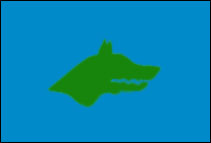
Flag of Köktürk Qaghanate
In the early 7th century, the Uyhurs were the subjects of the Eastern Gök Türk (aka Tujue, Kök Türük, Türük) Qaghanate; but when this qaghanate declined, they united with the Sir-Tardush Alliance and they rebelled against the Gök Türks. After overthrowing the Sir-Tardush, the Uyghur founded a semi-independent qaghanate in the Selenge Valley from where they could raid as far as Tashkend and Huanghe. This qaghanate was brought under Eastern Gök Türk rule again .In 714, the Uyghur, together with the other Toquz Oghuz, rebelled but the rebellion was put down by Qapghan Qaghan in 715. However, the Uyghur became the semi-independent vassals of the qaghanate's Western half. In 742, the Uyghur, Qarluqs and Basmïls rebelled, captured the Eastern Gök Türk's center Ötüken, killed the last Gök Türk rulers in 744 and destroyed the Gök Türk Qaghanate. However, in 745, the Qaghan of Basmïls was killed, the Qarluqs were defeated and they were forced to migrate; thus, the Uyghur became the supreme rulers of Mongolia.
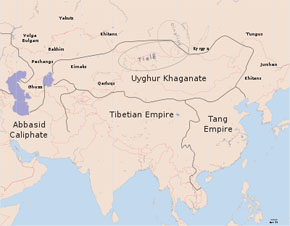
The first qaghan of the Uyghur was Qutlugh Bilge Köl Qaghan, who founded a new city, Ordu Balïq, also known as Qara Balghasun, and he moved the capital from Ötüken to there. He died in 747, and he was succeded by Bayan Chor (Moyan Chuo in Chinese; his Turkic title was Tengride Bolmïsh Il-Itmish Bilge Qaghan). Bayan Chor's main aim was to unite all the steppe peoples under the Uyghur banner; and he brought many peoples like the Sekiz Oghuz, Qïrghïz, Qarluqs, Türgish, Basmïls, Toquz Tatars and Chiks under Uyghur rule. As a result of these campaigns, the borders of the Uyghur Qaghanate reached Yenisey in the North, valleys of Chu and Talas in the West and the river Kerülen in the East. At that time, the Tang Dynasty of China began to withdraw from Central Asia. Bayan Chor acted quickly and captured the Tarim Basin, a fertile area full of farms and towns.
In the mid-8th century, China was shaken by a series of rebellions, the biggest being that of An Lushan. The Tang emperor asked Bayan Chor for help, the qaghan helped him to put down the rebellions and expel an invading Tibetan army, and then forced the emperor to pay tributes to the Uyghur. He married with the daughter of the emperor and died in 759.
Golden Age of the Uyghur Qaghanate:
After Bayan Chor's death, Bögü Qaghan (his title was Tengride Qut Bolmïsh Il-Tutmush Alp Külüg Bilge Qaghan) became the new ruler. At that time, China fell into a civil war, before the Uyghur could intervene, the rebellions were put down but the Uyghur became very influential in Tang China. In 762, Bögü Qaghan launched a campaign against the Tibetans with the Tang and he managed to re-capture Luoyang (the Western capital of Tang) from the Tibetans. During the campaign, Bögü Qaghan met with Manikheist priests and soon, he converted to Manicheism. After this, Manikheism became the official religion of the Uyghur Qaghanate.Bögü Qaghan later put down the Qïrghïz Rebellion and he decided to invade China again in 779, but his generals warned him about the difficulties and handicaps of such a possible invasion of such a wide area. A bitter arguement broke out between him and his generals, and during a quarrel, he was killed by Tun Bagha Tarqan, a famous Uyghur general.
Bagha Tarqan (titled as Alp Qutlugh Bilge Qaghan) was famous from his laws, which were made to secure the unity of the qaghanate. He defeated the Qïrghïz, married with a Tang princess and improved the Uyghur relationships with China.
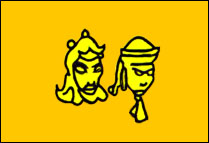
Flag of Uyghur Qaghanate
Decline and Collapse of the Uyghur Qaghanate:
Bagha Tarqan was succeded by his son Ay Tengride Qut Bolmïsh Külüg Bilge Qaghan who was succeded by Qutlugh Bilge Qaghan. During the reign of Qutlugh Bilge Qaghan, the Tibetans allied with the "Desert Turks" (Shatuo Tujue) and they raided the borders of the qaghanate. The Uyghurs tried to expel the raiders but they were defeated, which caused chaos in the Uyghur capital. In 795, Qutlugh Bilge Qaghan was killed but before the qaghanate fell into pieces, an Ediz-origined (Ediz were one of the Turkic tribes) general named Qutlugh (titled as Ay Tengride Ülüg Bolmïsh Alp Qutlugh Bilge Qaghan) was declared as the Uyghur qaghan. With Qutlugh, the Uyghur dynasty passed to the Ediz from the Yaghlaqar tribe. During his rule and his son Ay Tengride Qut Bolmïsh Külüg Bilge Qaghan's reign, the qaghanate lived in peace; especially Ediz Qutlugh was known from his ability in rulership and generalship. His son gave importance to trade and improved it in Inner Asia. After the peaceful reign of Ay Tengride Qut Bolmïsh Alp Bilge Qaghan, Ay Tengride Ülüg Bolmïsh Küchlüg Bilge Qaghan became the last great qaghan of the Uyghurs.
He stopped the invading Tibetans, appointed a Yabghu on the Qarluqs and improved commerce relationships up to Soghdiana. However, in 833, the qaghanate fell into anarchy and the qaghan was killed. His succesor and nephew Ay Tengride Qut Bolmïsh Alp Külüg Bilge Qaghan was killed in 839 by a rebellion commanded by one of his ministers. In the winter of 839, a famine broke out and in the spring of 840, the Qïrghïz invaded Mongolia. Qara Balghasun (Ordu Balïq) was captured, it was sacked and it's residents were massacred, including the last ruler Hesa Qaghan.
Several years after the fall of their capital, the Uyghurs fled towards south and southwest, where they set up two kingdoms in Gansu and Turfan (Gaochang) whereas an important number of them were massacred by their rivals. These states were not great military powers like their ancestors but they gave more importance to trade, arts and science. They also influenced the Mongols on a large scale later, who made Uyghur dialect one their official language of their empire (and the Uyghur script their official writing system).
From AllEmpire
Talas War
In the great Talas battle that took place between the Islamic forces that were reinforced by Uyghur and Karluk people and Chinese people, the Chinese people were totally defeated. This war ended up with the capture of Tarim basin by the Uyghur people. Upon this war, China retreated from the Central Asia. Therefore, some important events took place in China. The most important event was the capture of Lo-yang and C'ang-an (by a commander named as An-lu-san who had a Turkish mother with his forces composed of 200 thousands of people. Then, he declared his empire. Mo-yen-çur supported the T'ang emperor, Su-stung. He recaptured Lo-yang . Therefore, China guaranteed to submit an annual amount of 200 thousands of silk rolls to the Uyghur
840 CE – 1800 CE
Following the collapse of the Uyghur Khaganate, the Uyghur gave up Mongolia and established kingdoms in three areas: present day Gansu, Uyghur Region, and the Chu River the West of Tengri-Tag Mountains.
Yugor, The eastern-most of the three Uyghur states was the Ganzhou Kingdom (870–1036 CE), with its capital near present-day Zhangye in the Gansu province of China. There, the Uyghur converted from Manichaeism to Lamaism (Tibetan and Mongol Buddhism). Unlike other Turkic peoples further west, they did not later convert to Islam. Their descendants are now known as Yugurs (or Yogir, Yugor, and Sary Uyghurs, literally meaning “yellow Uyghurs”) and are distinct from modern Uyghurs. In 1028–1036 CE, the Yugors were defeated in a bloody war and forcibly absorbed into the Tangut kingdom.
Karakhoja, The central of the three Uyghur states was the Karakhoja kingdom (created during 856–866 CE), also called the “Idiqut” (“Holy Wealth, Glory”) state, and was based around the cities of Turpan (winter capital), Beshbalik (summer capital), Kumul, and Kucha. A Buddhist state, with state-sponsored Buddhism and Manicheism, it can be considered the center of Uyghur culture. The Idiquts (title of the Karakhoja rulers) ruled independently until 1209, when they submitted to the Mongols under Genghis Khan and, as vassal rulers, existed until 1335.

Flag of Karakhans
Kara-Khanids, or the Karakhans (Great Khans) Dynasty, was the westernmost of the three Uyghur states. The Karakhans (Karakhanliks) originated from Uyghur tribes settled in the Chu River Valley after 840 and ruled between 940–1212 in Turkistan and Maveraünnehir. They converted to Islam in 934 under the rule of Sultan Satuq Bughra Khan (920–956 AD) and, after taking power over Qarluks in 940, built a federation with Muslim institutions. Together with the Samanids of Samarkand, they considered themselves the defenders of Islam against the Buddhist Uyghur Idiqut. The first capital of the Karahans was established in the city of Balasagun in the Chu River Valley and later was moved to Kashgar.
The reign of the Uyghur’s Karakhans is especially significant from the point of view of Turkic culture and art history. During this period mosques, schools, bridges, and caravansarais were constructed in the cities. Kashgar, Bukhara and Samarkand became centers of learning. During this period, Turkic literature developed. Among the most important works of the period is Kutadgu Bilig (English: “The Knowledge That Gives Happiness”), written by Yusuf Balasaghuni between the years 1060–1070, and Lughat-at-Turk(The Turkic dictionary) by Mahmud of Kashgar.
Both the Idiqut and the Kara-Khanid states eventually submitted to the Kara Khitais. After the rise of the Seljuk Turks in Iran, the Kara-Khanids became nominal vassals of the Seljuks as well. Later they would serve the dual-suzerainty of the Kara-Khitans to the north and the Seljuks to the south. Finally all three states became vassals to Genghis Khan in 1209.
the second son of Genghis Khan who, at his father’s death, received Kashgaria (now the southern part of Uyghur Autonomous Region of Xinjiang, China) and most of Transoxania between the Amu Darya and the Syr Darya (ancient Oxus and Jaxartes rivers, respectively) as his vassal kingdom. His capital was at Almarikh near present-day Kuldja (Yining), in western Uyghur Region. Chagatai appears to have been a just and energetic ruler for about 14 years. Although it is recorded that he left numerous children, he was succeeded by a grandson, Kara Hülegü (Encyclopædia Britannica)
Most Uyghur inhabitants of the Besh Balik and Turpan regions did not convert to Islam until the 15th century expansion of the Yarkand Khanate, a Turko-Mongol successor state based in western Tarim. Before converting to Islam, Uyghurs were Tengriist, Manichaeans, Buddhists, or Nestorian Christians.
State of Yarkand ( Saidiye Khanate )
Tombs of Yarkand Khans (near Altyn Mosque)In May, 1514, Sultan Said Khan, grandson of Yunus Khan (ruler of Moghulistan between 1462 and 1487) and third son of Akhmad Khan, made an expedition against Kashgar from Andijan with only 5000 men, and having captured the Yangihisar citadel, that defended Kashgar from south road, took the city, dethroning Mirza Abu-Bakr. Soon after, other cities of Eastern Turkestan — Yarkand, Khotan, Aksu, and Uch Turpan — joined him, and recognized Sultan Said Khan as ruler, creating a union of six cities, called Altishahr. Sultan Said Khan's sudden success is considered to be contributed to by the dissatisfaction of the population with the tyrannical rule of Mirza Abu-Bakr and the unwillingness of the dughlat amirs to fight against a descendant of Chagatai Khan, deciding instead to bring the head of the slain ruler to Sultan Said Khan. This move put an end to almost 300 years of rule (nominal and actual) by the Dughlat Amirs in the cities of West Kashgaria (1219-1514). He made Yarkand the capital of a state, "Mamlakati Yarkand" which lasted until 1678.
The Khojah Period
In the 17th century, A Sufi master Khoja Āfāq defeated Saidiye kingdom and took the throne at Kashgar with the help of the Oirat (Dzungar) Mongols. The Khoja dynasty rule in the Altishahr(Tarim Basin) region lasted until 1759.
East Turkistan
To the west of Kashgaria in East Turkistan (now in western Uyghur Region), a khanate of Khokand emerged after 1760 in the Fergana region and became a powerful caravan trade centre. In 1762 the Qing government countered this by establishing a presence in the Ili (Yili) River region. When Muslim rebellion spread rapidly from Shaanxi and Gansu to East Turkistan, an adventurer from Khokand, Yakub Beg, seized the opportunity to captuted Kashgaria and established (Encyclopædia Britannica)"
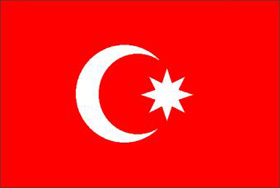
Flag of Kashgaria
Under Qing
Kashgar and the other cities of the Tarim basin remained under Yakub Beg's rule until December 1877. Yakub Beg's rule lasted until General Zuo Zongtang (also known as General Tso) reconquered the region in 1877 for Qing China. with the help of Uk and TsarIn 1881, Qing China recovered the Gulja region through diplomatic negotiations (Treaty of Saint Petersburg (1881)).
In 1884, Qing China renamed the conquered region, established and named Xinjiang ("new frontier") as a province, formally applying onto it the political system of China proper. For the 1st time the name "Xinjiang" replaced old historical names such as "Western Regions", "Chinese Turkestan", "Eastern Turkestan", "Uyghuristan", "Kashgaria", "Uyghuria" , "Alter Sheher" and "Yetti Sheher".
20th Century and after the Qing Dynasty
In 1912 the Qing Dynasty was replaced by the Republic of China. Yuan Dahua, the last Qing governor of Xinjiang, fled. One of his subordinates Yang Zengxin (杨增新), acceded to the Republic of China in March of the same year, and maintained control of Xinjiang until his death in 1928. Following insurgencies against Governor Jin Shuren (金树仁) in the early 1930s, a rebellion in Kashgar led to establishment of the short-lived First East Turkistan Republic (1st ETA) in 12 Nov, 1933. The ETR claimed authority over territory stretching from Aksu along the northern rim of the Tarim Basin to Khotan in the south. Uyghur region was brought under the control of the Chinese warlord Sheng Shicai (盛世才), who ruled Xinjiang for the next decade with close support from the Soviet Union, following some of its ethnic and security policies. Sheng invited a group of Chinese Communists to Uyghur Region, including Mao Zedong's brother Mao Zemin, but in 1943, fearing a conspiracy, Sheng killed all communists, including Mao Zemin, in Uyghur Region.
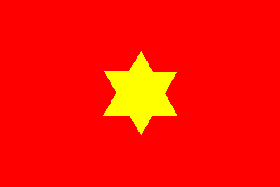
Sheng Shicai 's Flag
A Second East Turkistan Republic (2nd ETA, also known as the Three Districts Revolution) existed from 1944-1949 with Soviet support in what is now Ili Kazakh Autonomous Prefecture in northern Uyghur Region.
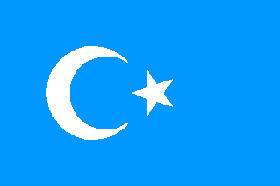
Flag of East Turkistan Republic
The Second East Turkistan Republic came to an end when the People's Liberation Army (PLA) entered Uyghur Region in 1949. According to the PRC interpretation, the 2nd ETA was Uyghur Region's revolution, a positive part of the communist revolution in China; the 2nd ETA acceded to and welcomed the PLA when they entered Uyghur Region, a process known as the Peaceful Liberation of Uyghur Region. However independence advocates view the ETA as an effort to establish an independent state, and the subsequent PLA entry as an invasion. The autonomous region of the PRC was established on October 1, 1955, replacing the province. The PRC's first nuclear test was carried out at Lop Nur, Uyghur Region, on October 16, 1964.

